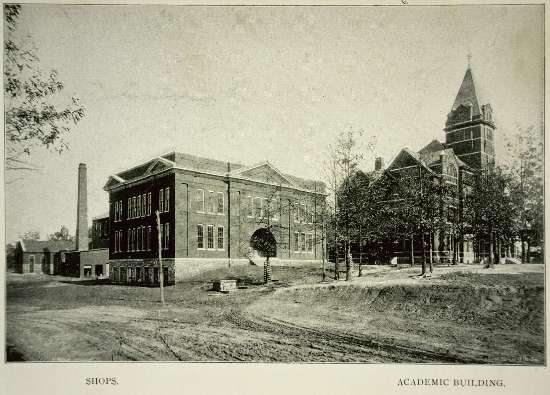 |
gtanno189697-000a
Location:
T171 .G42 G49x 1888-1899
Title: Date:
Shops. Academic Building
1897
Content:
Frontispiece photograph of the Shop Building and Academic Building in the Annual Catalog of the Georgia
School of Technology Announcement for 1896-1897
History:
This photograph shows the first two buildings of the Georgia School of Technology--the Academic and Shop
Buildings. The Academic Building and the original Shop Building, both erected in 1888, were designed by
the Architectural Firm Bruce and Morgan, according to the lofty high Victorian tenets popularized at the
time by John Ruskin. Buildings modeled after Ruskinian principles were heroic and ornate in design,
embued with the concept that civic and industrial activities were steeped in moral purpose. The first Shop
Building was destroyed by fire in April 1892. The Shop Building rebuilt in 1892 and pictured in this
photograph is more utilitarian, less ornate and majestic than the Academic Building with its dramatic
tower. The Shop Building reflects the frugality in replacing a destroyed building originally costing
$20,000 for less than $12,000 but also reflects the increasing dominance of the school culture over the
shop culture, as Georgia Tech moves from an emphasis on apprenticeship and trade development to scholarship
and academic pursuits. This new emphasis on the academic was reflected by the resignation of the first
President, Dr. Isaac S. Hopkins. Isaac S. Hopkins was President of Emory College in Oxford when he was
selected to be the Georgia School of Technology's first president in 1888. He was described as that "rare
combination of physicist and theologian." He had a strong interest in the value of learning a practical
trade and had established at Emory College a "rudimentary course in mechanics." He had such a strong
interest in the field of mechanics that at some point, presumably while at The Georgia School of
Technology, he worked as a master mechanic in Atlanta's railroad shop. The initial faculty was nicely
balanced between "art" and "technic," with five professors and four shop foremen. In 1888, "the course of
study was designed to meet the need for training in the industrial and mechanical arts; the methods were
such as had been found advantageous in the polytechnics schools of Europe and at the Worcester Polytechnic
School." The first and only degree offered was in Mechanical Engineering. President Hopkins resigned in
1895 to pursue his theological career. Dr. Lyman Hall, Professor of Mathematics and West Point graduate
was appointed President and began an ambitious program of building and land acquisition over the nine years
of his tenure. In December of 1896, the degrees of electrical and civil engineering were established.